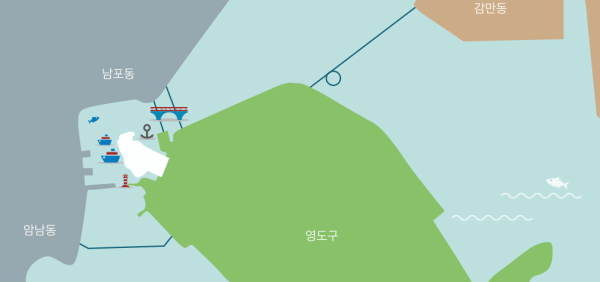Where is KANGKANGEE Village?
KANGKANGEE Village, which is a socks-shaped village, is at the opposite side of Jagalchi Market, Yeongdo Bridge, and Namhang Bridge. There is a lighters wharf, which is full of ships, and there are nearly 10 shipyards where ships are actively incoming and outcoming. Hence, it shows the originality of Busan as the capital of marine culture, which originated and flourished from its harbor. Daepyeong-dong is the birthplace of the modern shipbuilding industry, in which “Tanaka Shipyard”, the first modern shipyard in the late 19th century, was founded. Since then, it has been widely known for shipbuilding and ship-repairing, so that people has said, “There is no ship that cannot be repaired in Daepyeong-dong.” Still, dozens of repair shipyards and nearly 200 small industrial companies and vessel parts companies occupy most of the space in the village, showing the history of the shipbuilding industry.
What is the current status of KANGKANGEE Village?
The original name of the village is “Daepyeong-dong”. The area of the village was 162,631.1㎡, and it was formed by the land reclamation during the Japanese colonial period. The number of households is 1,176 and the population is 2,771 according to the statistics in 2015, and the elderly population aged 65 or over is 694, which is a quarter of the whole population. Due to the aging of the population, the number of an empty house has increased and the shipbuilding industry has faced an economic recession. However, recently “Daepyeong-dong KangKangee-gil” has been attracting attention as a new tourist spot along with the restoration of Yeongdo Bridge lifting system. Also, many modern historical heritages and shipbuilding industry facilities throughout the village enable the arts-based urban regeneration projects, which has been actively carried out.
What is the geographical advantage of KANGKANGEE Village?
KANGKANGEE Village is a gateway to Yeongdo and is near to many famous tourist attractions such as Bongnae-dong warehouse, Jeoryeong coastal walkway, Huinnyeoul culture village, and Namhang traditional market. Hence, it can play a central role in the local community by making a connection between the different cultural tourism resources. Based on the abundant marine living culture and the modern industrial heritage, it is possible to discover life and history of “people who crossed the sea”. Hence, the possibility of the new regeneration project can be striking as it is differentiated from the Sanbok-doro regeneration project with its famous Gamcheon Culture Village, which represents people who climbed the mountain.



